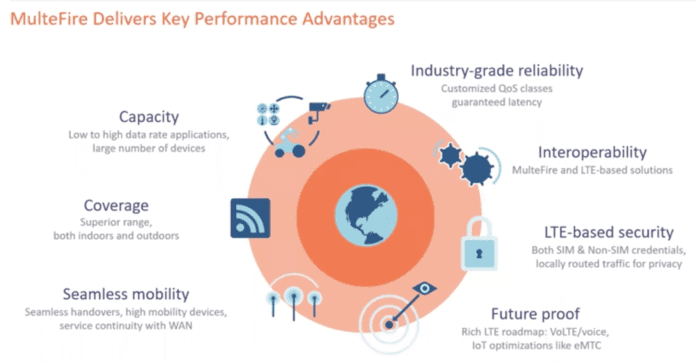Boingo Wireless CTO discusses MulteFire opportunity
The ability to deploy LTE in all unlicensed spectrum significantly lowers the barrier to entry for enterprises looking to take control of their connectivity needs. Driven by the MulteFire Alliance, and with compatible equipment coming to market, MulteFire will allow enterprise stakeholders to deploy private LTE networks or serve as a neutral host network provider.
In a recent webinar, MulteFire Alliance Board member and Boingo Wireless Chief Technology Officer Derek Peterson discussed the market dynamics shaping this emerging technology. He said using the 5 GHz band to deploy LTE supports an easy deployment process “much like Wi-Fi” while providing the capacity, coverage, seamless mobility, security and reliability we expect from LTE.
“Because it’s an LTE-based technology…you can get a superior range for both indoors and outdoors,” Peterson said. “And, of course, as we all start using more and more devices…we need capacity. As we move to 5G and we try to get 1 gigabit per person with one millisecond latency, it’s going to be important that we get smaller cells and support a large number of devices in a very dense environment. MulteFire delivers on that.”
Earlier this month Nokia announced it would demonstrate a MulteFire small cell and end-to-end private LTE network at the upcoming Mobile World Congress event in 2018 ahead of planned commercial availability in Q2. According to Nokia, it’s MulteFire small cell, the Flexi Zone MulteFire Multiband Pico BTS, supports downlink throughput up to 300 Mbps and comes in a four liter form factor. On the DAS side, ADRF announced during the Verizon Technology User Forum, it has updated its solution to include support for for the 3.5 GHz and 5 GHz spectrum bands.
Peterson explained that the MulteFire 1.0 specification draws from 3GPP Release 13 and 14 specifications that address Licensed Assisted Access (LAA) and enhanced LAA, which operators are using to aggregate licensed and unlicensed spectrum to create larger data pipes and, in turn, deliver higher levels of capacity.
“One of the key things about this spec,” Peterson said, “is it took the 3GPP standards and it leveraged those so we end up having the security and the interworking and all those key things we need to have a great performing LTE performance. One of the key things of the MulteFire 1.0 spec…is building this standalone nature for unlicensed operation. Existing LAA solutions and some of the earlier LTE-U solutions required you to have a carrier channel to support LAA. With the MulteFire spec it ends up removing that requirement which ends up freeing up more opportunity for deployments because you don’t have to have that licensed anchor.”
“The idea with MulteFire is today we’re focused on 5 GHz and 3.5 GHz, but tomorrow…when more spectrum becomes available, the spec could end up taking advantage of any unlicensed or shared spectrum model that’s available.”
Peterson explained how MulteFire brings LTE features to end users they may not be able to get carriers to invest in an in-building deployment. “In a traditional network that you’re deploying, you’re working side-by-side with the carrier. The challenge is that not all venues make sense and there’s only so much capital that each carrier has to bring to bear. There’s been requests or opportunities to be able to deploy in venues where the carriers may not have it as a priority. Those venues still want that coverage. Our traditional mobile deployments really rely heavily on the LTE spectrum and the carrier and their available money to be able to deploy. Going forward, as we start looking toward neutral host deployments, we can end up taking advantage of common spectrum, which reduces the cost of the deployment but then still meets all the needs of the carrier and the venue. It’s a really great opportunity to get LTE networks spread across ubiquitously all of our venues.”

